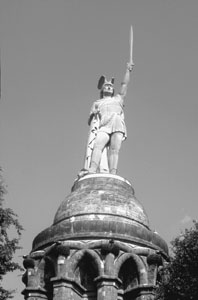

 | Page 580 |  |
and twentieth centuries (in 1871, 1918, 1933, 1945, and 1989) also represent crises and resolutions within prehistoric archaeology. Since the beginning of the nineteenth century we may distinguish a minimum of five major phases in prehistoric archaeology’s development.

The Hermannsdenkmal (Aminius Monument) near Detmold was erected in 1875 to commemorate the Roman defeat by Germanic tribes in the Teutoburg Forest in a.d. 9.
(Photograph by Ulrich Veit)
The first phase of development (1800–1871) was characterized by a growth of interest in prehistoric remains mainly on local or regional bases. About fifty new associations that dealt with antiquities of prehistoric and other ages were founded in the first decades of the nineteenth century. The first more systematic excavations took place—for example, the work in Hallstatt (from 1846 to 1864). This increased interest was the result of a growing romantic nationalism, reached its climax in the years before the German Revolution in 1848. It culminated in the establishment of a number of nationwide institutions that became influential in the development of prehistoric archaeology during the next phases. These include the Germanic National Museum (Germanisches Nationalmuseum) at Nuremberg and the Roman-Germanic Central Museum (Römisch-Germanisches Zentralmuseum) at Mainz, both of which were founded in 1852. According to its founder, ludwig lindenschmit (1809–1893), the aim of the latter institution was to unite the most important archaeological objects under one roof. Since it was not possible to get enough important original finds, Lindenschmit, who was an artist, developed the idea of making exact copies of all famous antiquities and exhibiting them in his museum. This allowed visitors to make broad comparisons on a scale that was not possible in earlier times.
The Hermannsdenkmal (Arminius Monument) near Detmold remains a symbol of romantic nationalism. This huge statue commemorates the German victory over the Romans under Varus in a.d. 9 in the dark forests of Germania. The monument, designed by Ernst von Bandel, shows Arminius raising his sword after his victory. Its foundation stone was set in 1838, but the monument was not finished until 1875, four years after the foundation of the German Reich.
This first phase in the development of prehistoric archaeology was followed by a period of further institutional consolidation and development, which coincided with the so-called Günderzeit, the years after the foundation of the German Reich in 1871. From that point forward associations such as the Berliner Gesellschaft für Anthropologie, Ethnologie und Urgeschichte, founded in 1869, were the most important institutions for the development of knowledge about prehistory. Rudolf Virchow (1821–1902) was the leading figure in prehistory during this period. Mainly known as a pathologist, physical anthropologist, and politician, Virchow also devoted much of his time to the organization and promotion of prehistoric research in Germany. He advocated the integration of archaeology into a comprehensive “prehistoric anthropology” that would include all
 |  |